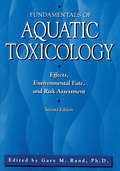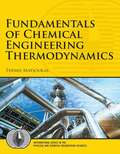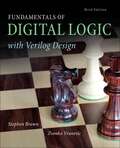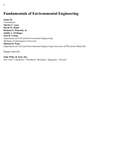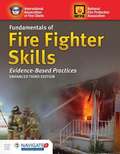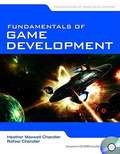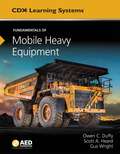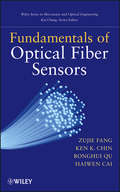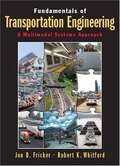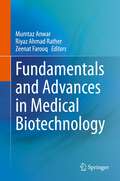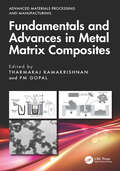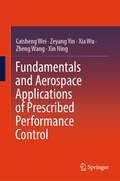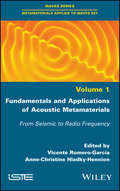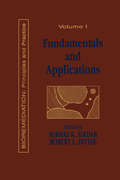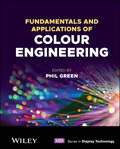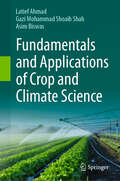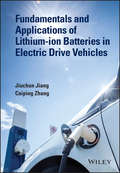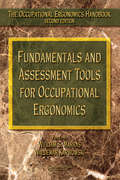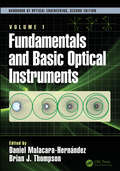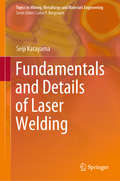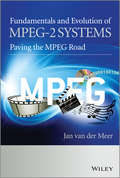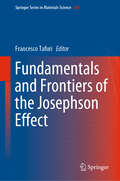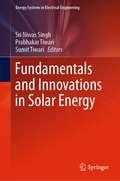- Table View
- List View
Fundamentals Of Aquatic Toxicology: Effects, Environmental Fate And Risk Assessment
by Gary M. RandThis text is divided into three parts. The first part describes basic toxicological concepts and methodologies used in aquatic toxicity testing, including the philosophies underlying testing strategies now required to meet and support regulatory standards.The second part of the book discusses various factors that affect transport, transformation, ultimate distribution, and accumulation of chemicals in the aquatic environment, along with the use of modelling to predict fate.; The final section of the book reviews types of effects or endpoints evaluated in field studies and the use of structure-activity relationships in aquatic toxicology to predict biological activity and physio-chemical properties of a chemical. This section also contains an extensive background of environmental legislation in the USA and within the European Community, and an introduction to hazard/risk assessment with case studies.
Fundamentals Of Chemical Engineering Thermodynamics (International Series In The Physical And Chemical Engineering Sciences Ser.)
by Themis MatsoukasThe Clear, Well-Organized Introduction to Thermodynamics Theory and Calculations for All Chemical Engineering Undergraduate Students This text is designed to make thermodynamics far easier for undergraduate chemical engineering students to learn, and to help them perform thermodynamic calculations with confidence. Drawing on his award-winning courses at Penn State, Dr. Themis Matsoukas focuses on “why” as well as “how.” He offers extensive imagery to help students conceptualize the equations, illuminating thermodynamics with more than 100 figures, as well as 190 examples from within and beyond chemical engineering. Part I clearly introduces the laws of thermodynamics with applications to pure fluids. Part II extends thermodynamics to mixtures, emphasizing phase and chemical equilibrium. Throughout, Matsoukas focuses on topics that link tightly to other key areas of undergraduate chemical engineering, including separations, reactions, and capstone design. More than 300 end-of-chapter problems range from basic calculations to realistic environmental applications; these can be solved with any leading mathematical software.
Fundamentals Of Digital Logic With Verilog Design
by Stephen Brown Zvonko VranesicFundamentals of Digital Logic With Verilog Designteaches the basic design techniques for logic circuits. It emphasizes the synthesis of circuits and explains how circuits are implemented in real chips. Fundamental concepts are illustrated by using small examples. Use of CAD software is well integrated into the book. The CAD software provides automatic mapping of a design written in Verilog into Field Programmable Gate Arrays (FPGAs) and Complex Programmable Logic Devices (CPLDs). Students will be able to try, firsthand, the book's Verilog examples (over 140) and homework problems. Engineers use Quartus CAD for designing, simulating, testing and implementing logic circuits. The version included with this text supports all major features of the commercial product and comes with a compiler for the IEEE standard Verilog language. Students will be able to: enter a design into the CAD system compile the design into a selected device simulate the functionality and timing of the resulting circuit implement the designs in actual devices (using the school's laboratory facilities) Verilog is a complex language, so it is introduced gradually in the book. Each Verilog feature is presented as it becomes pertinent for the circuits being discussed. To teach the student to use the Quartus CAD, the book includes three tutorials.
Fundamentals Of Environmental Engineering
by James R. MihelcicFundamentals of Environmental Engineering is the outgrowth of a team-taught course at Michigan Technological University which provides a bridge for a student to move from their basic science and math courses to their introductory and upper level environmental engineering courses which apply those fundamentals to local and global environmental problems. Fundamentals of Environmental Engineering presents those required fundamentals along with close to one hundred applications for a diverse set of relevant environmental situations including multimedia issues encompassing engineered treatment and chemical fate and transport in air, water, and soil.
Fundamentals Of Fire Fighter Skills: Evidence-based Practices
by National Fire Protection AssociationEach new print copy of Fundamentals of Fire Fighter Skills also includes Navigate 2 Advantage Access that unlocks a complete eBook, Study Center, homework and Assessment Center, and a dashboard that reports actionable data. Experience Navigate 2 today at www.jblnavigate.com/2. The National Fire Protection Association (NFPA) and the International Association of Fire Chiefs (IAFC) are pleased to bring you the third edition of Fundamentals of Fire Fighter Skills, the next step in the evolution of Fire Fighter I and Fire Fighter II training. With superior teaching and learning tools, the first and second editions of Fundamentals of Fire Fighter Skills set a new benchmark in fire fighter training. Now the NFPA, IAFC, and Jones & Bartlett Learning are proud to raise the bar for the fire service again. Comprehensive Content The third edition covers the entire spectrum of the 2013 Edition of NFPA 1001: Standard for Fire Fighter Professional Qualifications, as well as the requirements for Operations level responders in the 2013 Edition of NFPA 472: Standard for Competence of Responders to Hazardous Materials/Weapons of Mass Destruction Incidents. From fire suppression to hazardous materials to emergency medical care, this one volume covers all of Fire Fighter I and Fire Fighter II training requirements. The training program also includes coverage of the UL/NIST research studies and experiments on fire behavior and techniques for ventilation, fire suppression, and search and rescue as a result of the changes in modern building construction and furnishing materials. As a result of these changes, today's fires release energy faster, reach flashover potential sooner, may reach higher temperatures, and are much more likely to become ventilation-limited than building fires of even a few years ago. Tools for Success * Quickly identify Fire Fighter II content and skill drills through clear visual roadmaps. * Rapidly access content through clear and concise Knowledge and Skill Objectives with page references, as well as NFPA 1001 and 472 correlations. * Encourage critical thinking skills. Fire Fighter I and Fire Fighter II case studies offer students a genuine context for applying the knowledge presented in the chapter.
Fundamentals Of Game Development (Foundations of Game Development)
by Heather Maxwell Chandler Rafael ChandlerWritten by veterans who are currently working in the game industry, Fundamentals of Game Development is unique because it provides the practical aspects of the processes involved in developing and completing game projects. Designed for introductory game development and game production courses, this text provides a hands-on approach using examples and exercises to walk the reader through the entire process of developing a game from concept to completion. The book covers the basic topics discussed in an introductory text as well as history, game genres, design, story-telling, character creation, pre-production, code release, career descriptions, and more.
Fundamentals Of Mobile Heavy Equipment
by Gus Wright Owen Duffy Scott A. HeardFundamentals of Mobile Heavy Equipment provides students with a thorough introduction to the diagnosis, repair, and maintenance of off-road mobile heavy equipment. With comprehensive, up-to-date coverage of the latest technology in the field, it addresses the equipment used in construction, agricultural, forestry, and mining industries.
Fundamentals Of Mobile Heavy Equipment
by Gus Wright Owen Duffy Scott A. HeardFundamentals of Mobile Heavy Equipment provides students with a thorough introduction to the diagnosis, repair, and maintenance of off-road mobile heavy equipment. With comprehensive, up-to-date coverage of the latest technology in the field, it addresses the equipment used in construction, agricultural, forestry, and mining industries.
Fundamentals Of Optical Fiber Sensors
by Zujie Fang Ken K. Chin Ronghui Qu Haiwen CaiThis book describes the latest development in optical fiber devices, and their applications to sensor technology. Optical fiber sensors, an important application of the optical fiber, have experienced fast development, and attracted wide attentions in basic science as well as in practical applications. Sensing is often likened to human sense organs. Optical fiber can not only transport information acquired by sensors at high speed and large volume, but also can play the roles of sensing element itself. Compared with electric and other types of sensors, fiber sensor technology has unique merits. It has advantages over conventional bulky optic sensors, such as combination of sensing and signal transportation, smaller size, and possibility of building distributed systems. Fiber sensor technology has been used in various areas of industry, transportation, communication, security and defense, as well as daily life. Its importance has been growing with the advancement of the technology and the expansion of the scope of its application, a growth this book fully describes.
Fundamentals Of Transportation Engineering: A Multimodal Systems Approach
by Jon D. Fricker Robert K. WhitfordCombining topics that are essential in an introductory course with information that is of interest to those who want to know why certain things in transportation are the way they are, the book provides a strong emphasis of the relationship between the phases of a transportation project. The volume familiarizes readers with the standard terminology and resources involved in transportation engineering, provides realistic scenarios for readers to analyze and offers numerous examples designed to develop problem solving skills. The volume examines transportation basics, traffic flow theory and analysis, highway design for performance, modeling transportation demand and supply, planning and evaluation for decision-making, design of highway for safety, design of intersections for safety and efficiency, pavement design, public mass transportation, air transportation and airports and environmental issues/emerging technologies. For those interested in transportation engineering.
Fundamentals and Advances in Medical Biotechnology
by Mumtaz Anwar Riyaz Ahmad Rather Zeenat FarooqThis book serves as an introduction to the concepts of medical biotechnology, with great details about fundamentals and early disciplines of study as well as emerging fields and the latest research. The book follows a chronological order from the earliest discoveries and breakthroughs of medical biotechnology to the latest areas of study. The book contains up-to-date citations for each chapter and section, which makes it easy for the reader to understand the concept and also to follow the latest developments in the particular area. It is an ideal book for undergraduate and graduate students who aspire to derive basic knowledge and are also keen on learning about the latest advancements in the field of medical biotechnology.
Fundamentals and Advances in Metal Matrix Composites (Advanced Materials Processing and Manufacturing)
by Tharmaraj Ramakrishnan Pm GopalThe scope of this book covers the fundamental background of metal matrix composites (MMCs), their processing and fabrication, testing and characterization, exploration of materials for MMCs and green MMCs, and advancements in all aspects of fabrication, testing, and applications. Development or fabrication of MMCs with evaluation of mechanical and tribological properties as well as machinability evaluation, optimization of fabrication process, and machining operations are covered.Features: Covers advanced processing strategies and machining studies for composite materials Discusses representative volume element-based FEM modelling approaches and sustainability Sheds light on advancements in MMC application, fabrication, and testing Reviews green MMCs and sustainability in MMCs development Includes case studies and intelligent modelling methodologies This book is aimed at graduate students, researchers, and professionals in micro/nanoscience and technology, mechanical engineering, industrial engineering, metallurgy, and composites.
Fundamentals and Aerospace Applications of Prescribed Performance Control
by Zheng Wang Caisheng Wei Zeyang Yin Xia Wu Xin NingThis book systematically presents the state of the art in prescribed performance control theory in terms of incomplete state information, actuator saturation and faults, constrained communication bandwidth and task time window, as well as collision avoidance, and more. It provides a thorough presentation of fundamental structure, controller design, and analysis, as well as simulation studies of aerospace applications. The book aims to offer a valuable guide for researchers and aerospace engineers to address the theoretical and technical difficulties in different aerospace craft applications, ranging from spacecraft attitude and orbital control to space robotic operations. Meanwhile, it can also work as a professional reference book for senior undergraduate students and postgraduate students in fields such as automation and aerospace engineering.
Fundamentals and Applications of Acoustic Metamaterials: From Seismic to Radio Frequency
by Vicente Romero-García Anne-Christine Hladky-HennionIn the last few decades, metamaterials have revolutionized the ways in which waves are controlled, and applied in physics and practical situations. The extraordinary properties of metamaterials, such as their locally resonant structure with deep subwavelength band gaps and their ranges of frequency where propagation is impossible, have opened the way to a host of applications that were previously unavailable. Acoustic metamaterials have been able to replace traditional treatments in several sectors, due to their better performance in targeted and tunable frequency ranges with strongly reduced dimensions. This is a training book composed of nine chapters written by experts in the field, giving a broad overview of acoustic metamaterials and their uses. The book is divided into three parts, covering the state-of-the-art, the fundamentals and the real-life applications of acoustic metamaterials.
Fundamentals and Applications of Bioremediation: Principles, Volume I (Fundamentals And Applications Of Bioremediation Ser. #1)
by SubhasK. SikdarFROM THE INTRODUCTIONThis three-volume set, Bioremediation: Principles and Practice, provides state of the art description of advances in pollution treatment and reduction using biological means; identify and address, at a fundamental level, broad scientific and technological areas that are unique to the subject or theme and that must be understood if advances are to be made; and provide a comprehensive overview of new developments at the regulatory, desk-top, bench-scale, pilot scale, and full-scale levels. The set covers all media-air, water, and soil/sediment-and blends the talents, knowledge, and know-how of academic, industrial, governmental, and international contributors.The set addresses the removal of both hazardous and nonhazardous contaminants from the liquid, solid, and gas phase using biological processes. This includes the biological treatment of wastes of municipal and industrial origin; bioremediation of leachates, soils, and sediments; and biofiltration for contaminated gases.
Fundamentals and Applications of Colour Engineering (Wiley Series in Display Technology)
by Phil GreenFUNDAMENTALS AND APPLICATIONS OF COLOUR ENGINEERING EXPERT OVERVIEW OF THE WORLD OF COLOUR ENGINEERING IN THE 21ST CENTURY, WITH NEW, UPDATED TECHNOLOGIES AND A MATLAB TOOLBOX Fundamentals and Applications of Colour Engineering provides important coverage on topics that hold the power to extend our knowledge of colour reproduction, such as colour measurement and appearance and the methods used, with additional discussion of the technologies responsible for reproducing colour across a wide range of devices, together with the colour management systems that are used to connect devices and exchange information. Composed of 20 chapters, the Editor and his team of expert contributors consider the new ICC.2 architecture, an approach that introduces an evolutionary step in colour engineering, ensuring wider possibilities for technology. The text also considers the emerging applications for advanced colour management, such as processing spectral data, handling HDR images, and the capture and reproduction of material appearance. The text is supported by a MATLAB toolbox of relevant functions and data. Fundamentals and Applications of Colour Engineering is a useful reference for anyone involved in the reproduction of colour and a strong supplementary course potential for master???s degrees with a colour science component. Fundamentals and Applications of Colour Engineering includes information on: Instruments and methods of colour measurement, colorimetry, and colour difference, and colour appearance Colour spaces and colour encodings, and characterizing input devices, displays and printers Colour gamut communication and imaging standards, high dynamic range imaging, and HDR Sensor adjustment in colour management, open source tools for colour engineering, and colour transform evaluation Supporting active learning with the inclusion of a toolbox of relevant functions and data, Fundamentals and Applications of Colour Engineering is an essential resource for students in relevant programs of study, and for professionals within colour engineering and reproduction looking to maximize their skill set and keep their skills updated.
Fundamentals and Applications of Crop and Climate Science
by Latief Ahmad Asim Biswas Gazi Mohammad ShahThis book encompasses all aspects and perspectives of crop and climate science. It aims to serve as the authoritative resource for undergraduate students seeking answers and insights into the field of crop science and agro meteorology. The book covers a wide range of topics, starting from the foundational principles of crops and extending to various meteorological phenomena. It is built upon the latest research in crop science and agro-meteorology, providing clear and concise explanations without unnecessary filler content. The transitions between topics are smooth and coherent, ensuring optimal comprehension. The initial chapters focus on the fundamental principles of crop science, while the later sections delve into the concepts and practices of agro-meteorology. This book is specifically designed for advanced undergraduate students and beyond studying crops, meteorology, horticulture, forestry, fisheries, and related fields. Special care has been taken by authors to match the content with current scenario and advancement in the field of agriculture sciences.
Fundamentals and Applications of Lithium-ion Batteries in Electric Drive Vehicles
by Jiuchun Jiang Caiping ZhangA theoretical and technical guide to the electric vehicle lithium-ion battery management system Covers the timely topic of battery management systems for lithium batteries. After introducing the problem and basic background theory, it discusses battery modeling and state estimation. In addition to theoretical modeling it also contains practical information on charging and discharging control technology, cell equalisation and application to electric vehicles, and a discussion of the key technologies and research methods of the lithium-ion power battery management system. The author systematically expounds the theory knowledge included in the lithium-ion battery management systems and its practical application in electric vehicles, describing the theoretical connotation and practical application of the battery management systems. Selected graphics in the book are directly derived from the real vehicle tests. Through comparative analysis of the different system structures and different graphic symbols, related concepts are clear and the understanding of the battery management systems is enhanced. Contents include: key technologies and the difficulty point of vehicle power battery management system; lithium-ion battery performance modeling and simulation; the estimation theory and methods of the lithium-ion battery state of charge, state of energy, state of health and peak power; lithium-ion battery charge and discharge control technology; consistent evaluation and equalization techniques of the battery pack; battery management system design and application in electric vehicles. A theoretical and technical guide to the electric vehicle lithium-ion battery management system Using simulation technology, schematic diagrams and case studies, the basic concepts are described clearly and offer detailed analysis of battery charge and discharge control principles Equips the reader with the understanding and concept of the power battery, providing a clear cognition of the application and management of lithium ion batteries in electric vehicles Arms audiences with lots of case studies Essential reading for Researchers and professionals working in energy technologies, utility planners and system engineers.
Fundamentals and Applications of Micro- and Nanofibers
by Alexander L. Yarin Alexander L. Yarin Behnam Pourdeyhimi Seeram Ramakrishna Behnam PourdeyhimiA comprehensive exposition of micro and nanofiber forming, this text provides a unified framework of all these processes (melt and solution blowing, electrospinning, and so on) and describes their foundations, development and applications. It provides an up-to-date, in-depth physical and mathematical treatment, and discusses a wide variety of applications in different fields, including nonwovens, energy, healthcare and the military. It further highlights the challenges and outstanding issues from an interdisciplinary perspective of science and technology, incorporating both fundamentals and applications. Ideal for researchers, engineers and graduate students interested in the formation of micro and nanofibers and their use in functional smart materials.
Fundamentals and Assessment Tools for Occupational Ergonomics (The Occupational Ergonomics Handbook, Second Edition)
by Waldemar Karwowski William S. MarrasCompletely revised and updated, taking the scientific rigor to a whole new level, the second edition of the Occupational Ergonomics Handbook is now available in two volumes. This new organization demonstrates the enormous amount of advances that have occurred in the field since the publication of the first edition. The second edition not only provi
Fundamentals and Basic Optical Instruments (Optical Science and Engineering)
by Daniel Malacara-Hernández Brian J. ThompsonFundamentals and Basic Optical Instruments includes thirteen chapters providing an introductory guide to the basics of optical engineering, instrumentation, and design. Topics include basic geometric optics, basic wave optics, and basic photon and quantum optics. Paraxial ray tracing, aberrations and optical design, and prisms and refractive optical components are included. Polarization and polarizing optical devices are covered, as well as optical instruments such as telescopes, microscopes, and spectrometers.
Fundamentals and Details of Laser Welding (Topics in Mining, Metallurgy and Materials Engineering)
by Seiji KatayamaThis highly illustrated book presents the essential information and major constituents of laser welding, including laser brazing and laser-arc hybrid welding. Students, engineers, researchers, scientists, specialists, professors, consultants, designers, and executives worldwide will fully grasp the fundamentals, the present state, and the applications of laser welding. Welding phenomena, formation mechanisms and preventive procedures of welding defects, and process monitoring and adaptive control are especially emphasized, because understanding these aspects of laser welding greatly improves the performance of work and research and solves many problems in the field. Finally, the book shows how increasingly widespread use of a variety of materials is bringing major advances to laser welding.
Fundamentals and Evolution of MPEG-2 Systems
by Jan Van der MeerThis book describes the fundamentals and details of MPEG-2 Systems technologyWritten by an expert in the field, this book examines the MPEG-2 system specification as developed in the early 1990's, as well as its evolution into the fourth edition of the MPEG-2 systems standard, published in 2013. While MPEG-2 systems will continue to evolve further, this book describes the MPEG-2 system functionality as of October 2013. Furthermore, relevant background information is provided. The discussion of MPEG-2 system functionality requires knowledge of various fundamental issues, such as timing, and supported content formats. Therefore also some basic information on video and audio coding is provided, including their evolution. Also other content formats supported in MPEG-2 systems are described, as far as needed to understand MPEG-2 systems.Ordered logically working from the basics and background through to the details and fundamentals of MPEG-2 transport streams and program streamsExplores important issues within the standardization process itselfPuts the developments on MPEG-2 systems into historic perspectiveIncludes support of 3D Video and transport of AVC, SVC and MVCConcludes with additional issues such as real-time interface, delivery over IP networks and usage by application standardization bodiesPredicts a continuing promising future for MPEG-2 transport streams
Fundamentals and Frontiers of the Josephson Effect (Springer Series in Materials Science #286)
by Francesco TafuriThis book provides a comprehensive and up-to-date description of the Josephson effect, a topic of never-ending interest in both fundamental and applied physics. In this volume, world-renowned experts present the unique aspects of the physics of the Josephson effect, resulting from the use of new materials, of hybrid architectures and from the possibility of realizing nanoscale junctions. These new experimental capabilities lead to systems where novel coherent phenomena and transport processes emerge. All this is of great relevance and impact, especially when combined with the didactic approach of the book. The reader will benefit from a general and modern view of coherent phenomena in weakly-coupled superconductors on a macroscopic scale. Topics that have been only recently discussed in specialized papers and in short reviews are described here for the first time and organized in a general framework. An important section of the book is also devoted to applications, with focus on long-term, future applications. In addition to a significant number of illustrations, the book includes numerous tables for comparative studies on technical aspects.
Fundamentals and Innovations in Solar Energy (Energy Systems in Electrical Engineering)
by Sri Niwas Singh Prabhakar Tiwari Sumit TiwariThis book provides recent trends and innovation in solar energy. It covers the basic principles and applications of solar energy systems. Various topics covered in this book include introduction and overview of solar energy, solar PV generation, solar thermal generation, innovative applications of solar energy, smart energy system, smart grid and sustainability, solar energy forecasting, advances in solar battery, thermal storage of solar energy, solar energy pricing, advances in hybrid solar system, solar system tracking for maximum power generation, phase change materials and its application, sensitivity analysis in solar systems, environmental feasibility of solar hybrid systems, regulatory implications of solar energy integration with grid, impact of the photovoltaic integration on the hydrothermal dispatch on power systems and potential and financial evaluation of floating solar PV in Thailand—a case study. This book will be useful for the students, academicians, researchers, policymakers, economists and professionals working in the area of solar energy.
